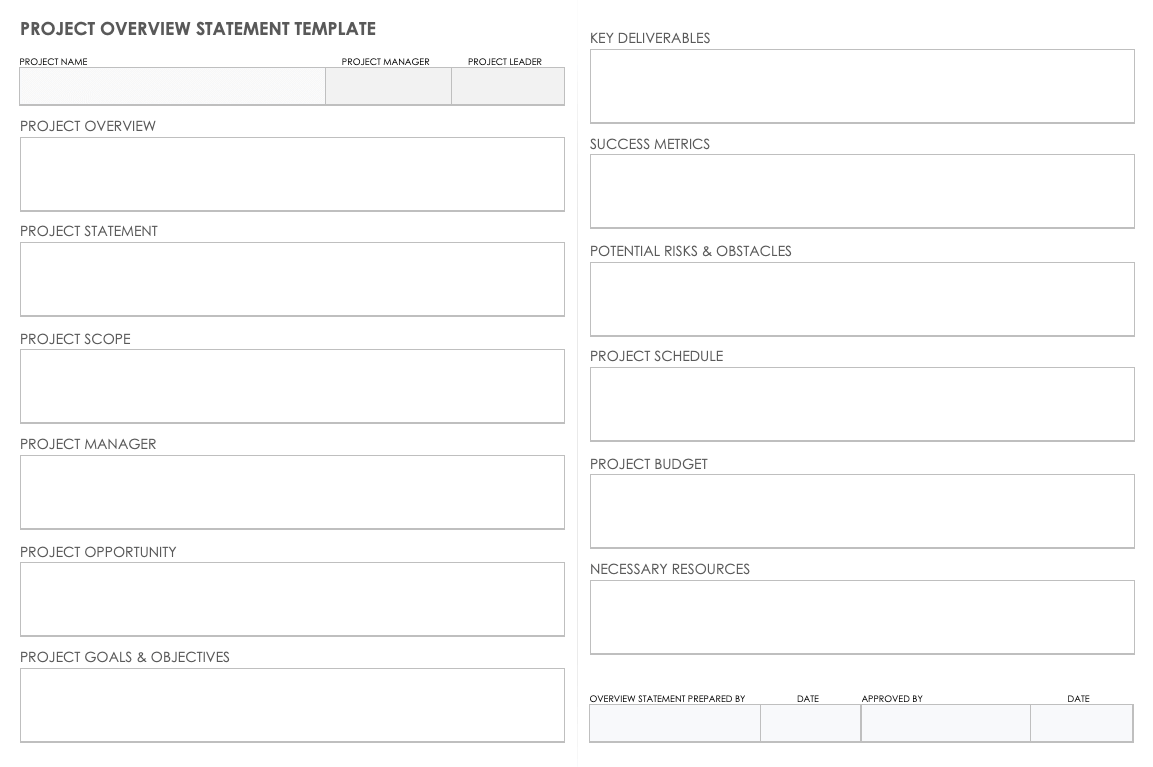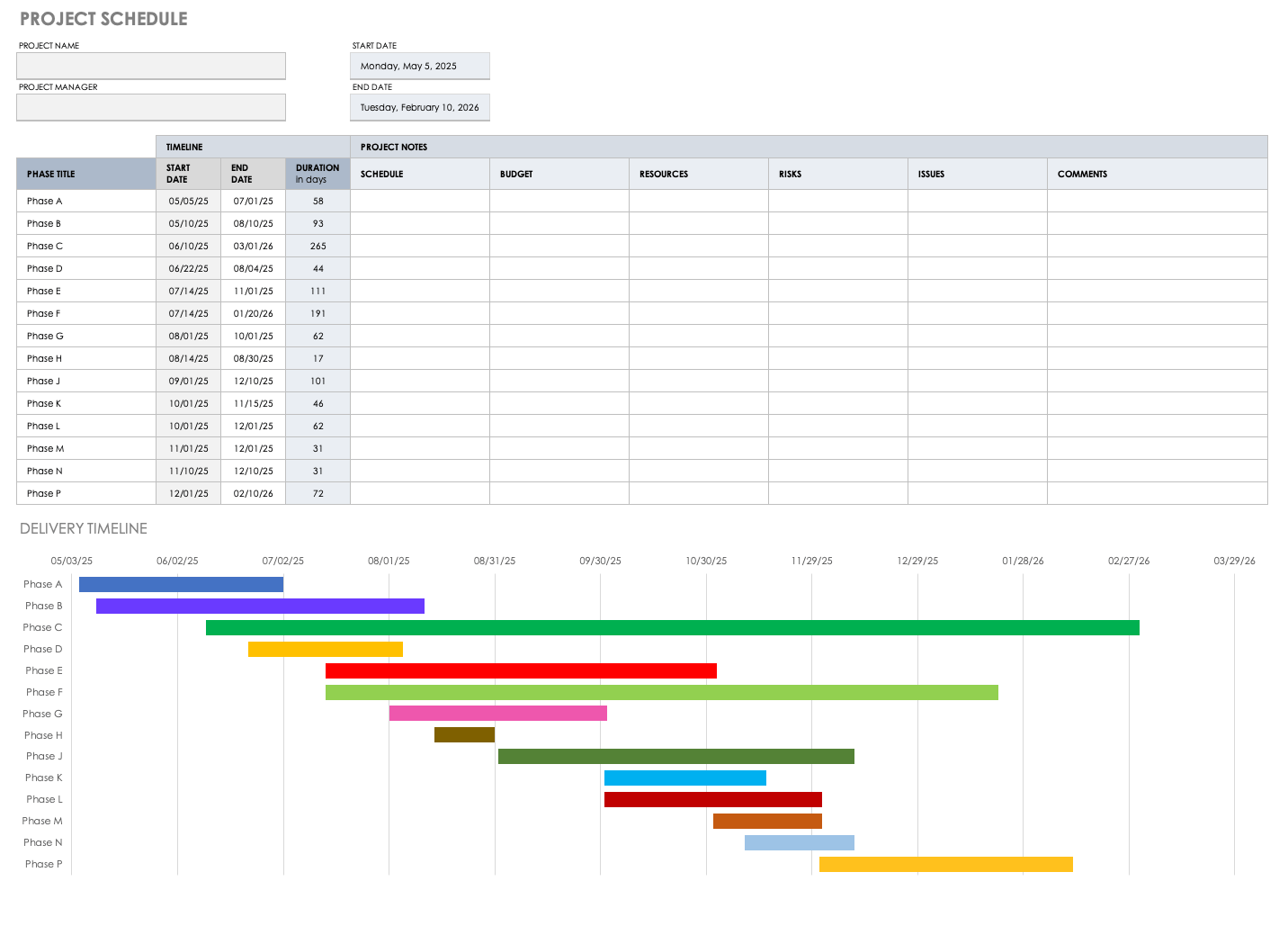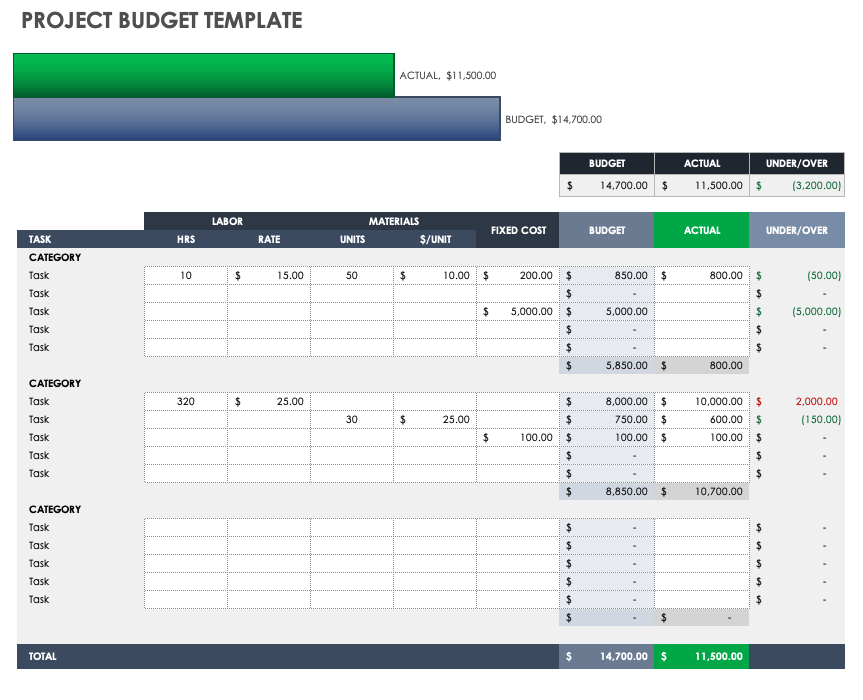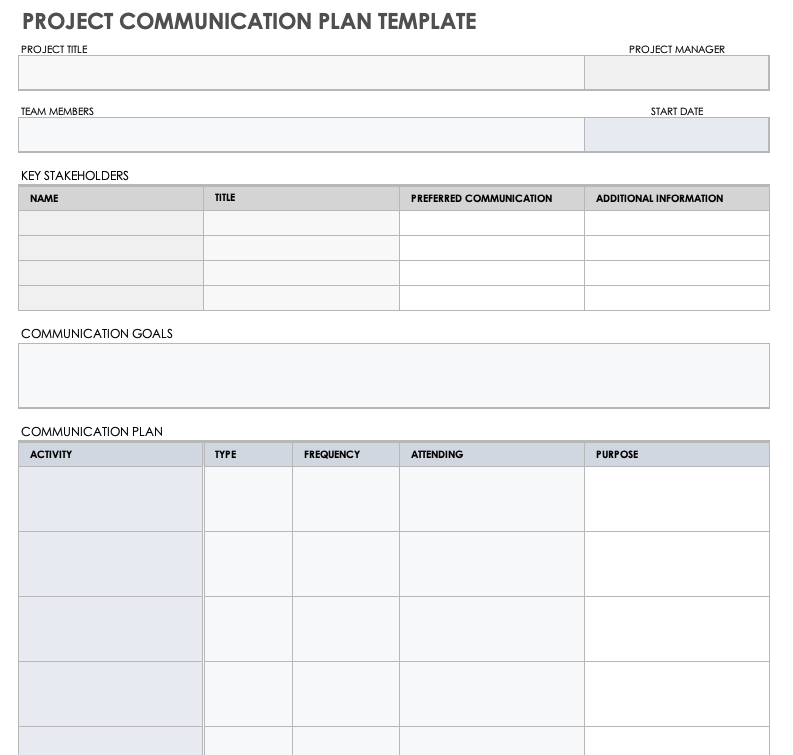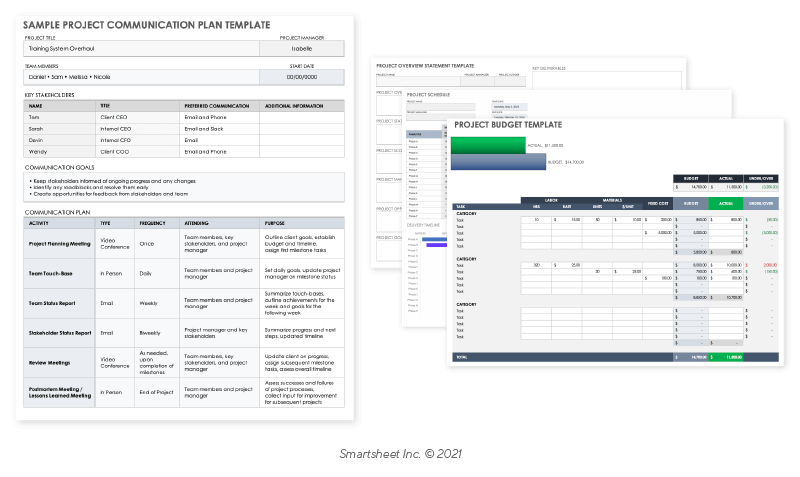What Is a Project Plan?
A project plan is a document that outlines what’s needed to complete a project. This can cover a project scope overview, a budget breakdown, a detailed schedule of deliverables, and a rundown of potential risks and stakeholders.
A project plan contains much of the same information as a project charter, but includes finalized details and a more specific schedule and budget. Think of a project charter as the blueprint for your project plan; the charter lays out your intent before the project begins. A project plan maps out the processes necessary to complete it. Your project plan should always be up to date and serve as a source of truth for a project’s status.
How to Write a Project Plan
Writing a project plan starts with finalizing your project information. Create an overview and a scope statement, determine a deliverables schedule, and define a budget. Include a risk management strategy, a communication plan, and any other documents your project needs.
Project planning is fundamentally about balancing the goals, schedule, and costs in a way that demonstrates that you can control the project’s scope. You may consider adopting the use of project planning templates to maintain consistency between projects and build on them over time.
A project plan also includes all the supporting documents that walk your stakeholders, clients, and team through the project.
1. Write a Project Overview
The overview is a short introduction to the project, not exceeding a page or so in length. Summarize the high-level details, covering project goals, deliverables, success measurements, and dependencies. Include the project’s sponsors and their titles, and name the project.
Add links to project portals or dashboards to give stakeholders a place to conveniently check on status and to access more detailed documents in the project plan.
Download Project Overview Statement Template
Microsoft Word | Adobe PDF
Use this template to provide a high-level summary of a project’s goals, scope, risks, schedule, budget, and success metrics. Add links to your company’s risk management plan, a detailed budget, and your project schedule. This template is fully customizable, so you can add or remove text to include only the information you need.
2. Define the Project’s Scope
Outlining your project’s scope is important for controlling scope creep. Define the project’s deliverables and goals. It is just as crucial to highlight what is within a project’s scope as what is outside of it.
A project’s scope may shift, but consider the changes against the project as a whole and update them in the project plan when approved.
3. Create a Project Schedule
The project schedule should be visual and easy to read, showing how each task contributes to the project’s main goal. Note the people and resources needed for each task and subtask, how long each will take, and the dependencies between them.
Depending on your project management strategy, you might consider using Gantt charts, Kanban boards, or shared calendars to create the schedule. Whatever you choose, ensure that your project status is updated on the schedule and that tasks are marked when started, completed, or falling behind.
Leave room in your schedule for roadblocks, emergencies, and tasks that may take more time. Consult with your team about how long each task has required in the past and use their feedback to inform the schedule. Create the schedule based on how long the work takes, not how long you wish it would take.
Download Project Schedule Template
Microsoft Excel | Google Sheets | Smartsheet
Use this customizable project schedule template to create a visual map of your project’s tasks and phases. The template will use any dates you add to the matrix to create a Gantt chart. You also have space for project notes.
4. Finalize the Project Budget
Your project plan should have the approved spending plan or time-phased budget that lists all costs by time period. Make sure to itemize the budget and keep it as close to reality as possible. Include room in the budget for unforeseen and emergency expenditures, and account for any additional resources you may need. Plan to update it immediately when emergencies arise or when tasks cost more. It is important to know ahead of time what kind of costs need executive approval and to make a plan to get that approval ahead of time.
Download Project Budget Template
Microsoft Excel | Google Sheets
Use this customizable project budget template to create a detailed, line-item budget for the project. Add labor and materials rates or the fixed cost for each task in your project. The template will automatically calculate the costs and compare your actual budget to your estimates, so it’s easy to tell if you’re going over.
5. Identify a Risk Management Strategy
Make a list of the specific risks your project faces, and outline a strategy to manage them. If your company already has a general risk management plan in place, it may not be necessary to reproduce it in your project plan as long as you highlight the individual risks that apply to your project. Talk to other project managers and your team about the obstacles they faced, and ask for tips for addressing similar challenges.
6. Write a Communication Plan
Create a communication plan to establish how and when you’ll share updates with stakeholders. The plan will list your project’s key stakeholders and team members, as well as their contact information and when they should receive project updates. You can use this document to outline the kinds of updates each stakeholder wishes to receive, and map out a schedule for planned meetings and reports.
Download Project Communication Plan Template
Microsoft Word | Adobe PDF | Google Docs
Download this project communication plan template to document your key stakeholders’ contact details and their preferred contact style and frequency. Input your communication goals and customize the plan to include scheduled meetings, progress reports, and status reports.
7. Finalize All Documents and Get Sponsor Approval
The final project plan should include all of the information above and any additional documents that might be relevant to your particular project.
Additional elements you might include in a project plan include the following:
- A link to your project charter
- A quality assurance plan
- Your work breakdown structure
- Your project management methodology or framework
- Links and access to necessary permits and certifications
Present the final plan to your sponsor and get their approval. If they request any changes, take this opportunity to make them.
8. Save and Share Your Plan
Once you’ve approved your project plan, save it in a centralized, easily accessible location, and share it with project stakeholders and your team. Ensure that all schedule and budget documents are updated regularly so that the project plan always accurately reflects your project’s status. Any critical changes to the plan itself should only be adjusted through the approved change control and management process.
Tips for Writing a Good Project Plan
Writing a good project plan begins with good organization. Use templates and software to keep your plan up to date and accessible.
Follow these tips for writing a good project plan:
- Write Clearly: Don’t complicate the plan with details that your audience already knows, such as your organization’s existing risk management or change control policies. Provide the information that your readers need to know about the specific project, not the entire company.
- Use Formatting and Be Specific: Some people will skim the plan, while others will pore over every detail. To make it consumable for all, use visual charts for schedules and budgets, bullet points for lists, and bold fonts to highlight important details. The skimmers will get the high-level information they need, and the detail-oriented will be able to drill down into the information they want.
- Keep It Updated: Even though the project plan contains a series of documents, don’t let it become something that stakeholders ignore or forget because it no longer has relevant information. Use an updated project plan to maintain support and enthusiasm for the work ahead.
- Use Your Project Charter: The project charter is the basis for your project plan. A detailed project charter includes similar information. Build off of the speculative schedules and budgets you already created.
- Use Templates and Software: Using project plan templates for your project plan documents is a great way to ensure consistency between teams and projects. Many project management software solutions also provide methods for creating, organizing, and sharing project plan information as well.
- Involve Your Team: Make sure to talk with your team before the project starts. They are the people who ensure the project succeeds, so get their input and buy-in during the planning process. They will likely have insight that you do not, and they will ask questions that will surface important details. Involving your team in the planning process also builds trust, as they feel closer to the project and more invested in its success.
Project Plan Starter Kit
Download Project Plan Starter Kit
We’ve collected the templates above to create a project plan starter kit that makes it easy to write your own project plan. In this kit, you’ll find customizable templates to create a project overview, a project budget, a detailed schedule, and a communication plan. Together, these documents form the foundation of a solid project plan and will help get your project off the ground.
Use Smartsheet Project Management Tools to Create and Implement Your Project Plan
Empower your people to go above and beyond with a flexible platform designed to match the needs of your team — and adapt as those needs change. The Smartsheet platform makes it easy to plan, capture, manage, and report on work from anywhere, helping your team be more effective and get more done. Report on key metrics and get real-time visibility into work as it happens with roll-up reports, dashboards, and automated workflows built to keep your team connected and informed. When teams have clarity into the work getting done, there’s no telling how much more they can accomplish in the same amount of time. Try Smartsheet for free, today.
